5 Ways to Leverage DrugBank's API
Learn about the best ways you can leverage our Clinical API.
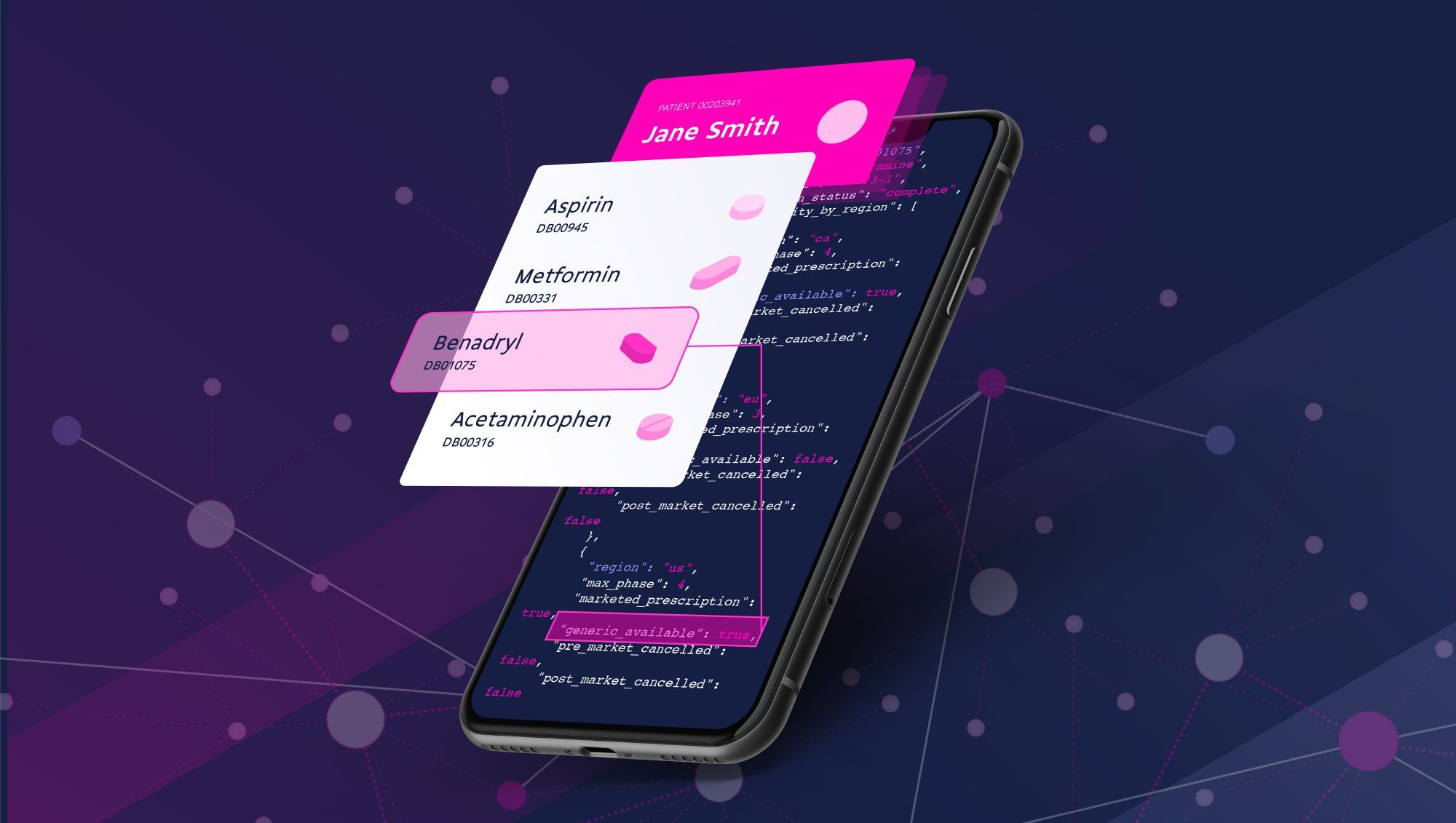
DrugBank’s Clinical API is a powerful tool that can be put to use across a vast array of use cases including everything from EMR/EHR to hospice and precision medicine. One key element that enables this diverse application is that our Clinical API connects many points of data through unique modules to provide specific insights that can educate and empower users. But because there are so many different uses and use cases it can be tough to know what’s right for you, or even what’s possible.
To help you out we’ve compiled the top five ways to leverage our Clinical API.
Table of Contents
Drug Search
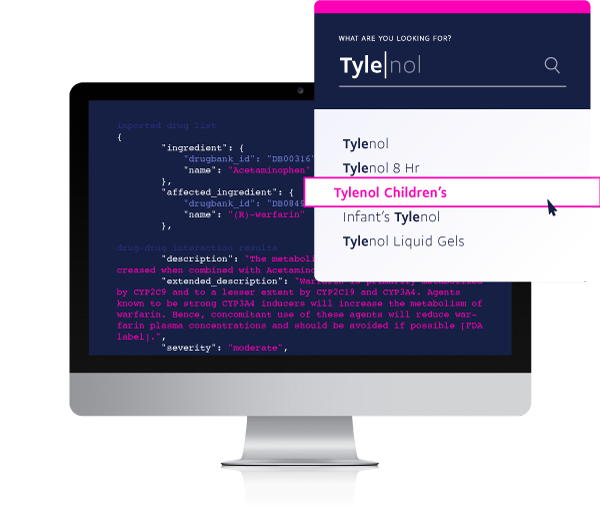
The ability to search drug products is by far the most popular way to use DrugBank’s Clinical API across all use cases. It also provides a starting structure that enables users to reach additional clinical insights available through DrugBank.
While there’s a handful of ways to do drug searches, our two most recommended are:
Both approaches have unique strengths and challenges that can benefit different use cases. Dig into the details to see which one makes the most sense for your needs.
Product Concepts Search
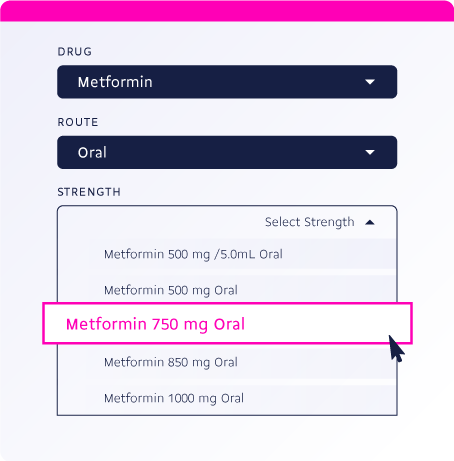
This is our most structured, user-friendly, and versatile drug product search that pinpoints a specific drug product by suggesting available forms, routes, or strengths. From here users can easily navigate between related products and filter products at increasing levels of detail due to the hierarchical nature of our product concepts.
Product concept searches are highly customizable. For example, you could start by entering the name of a drug product (either the generic or brand name) and then incorporate other aspects of the product like the route, form, and strengths before adding a range of other parameters to help narrow your search. As a result you get highly detailed and targeted search results.
If your users are medically trained and already know the specifics they are searching for, it might be a good idea to try our minimum level searches (a level represents the amount of information that is captured in a product concept ID). This feature alters the search to filter out any lower level of the product concept. By removing lower level information you end up with a one step specific drug product search that is quite similar to a drug names search, but each ID represents a group of drug products preventing potential repetition and confusion.
We do know that the product concept searches can be a bit tricky to use at first because it takes longer to integrate and learn. Taking this into account, we’ve developed a plug and play solution that can be integrated in less than a day and will do the heavy lifting for you! Check out our product concept plug and play solution if you are interested.
Why users love it:
- Well structured
- Super user-friendly
- Customizable
- Can be changed to a one step search
- Captures as much information as you want to capture
- Connected to RxCUI codes
- Features auto-complete
Considerations:
- Steep learning curve
- Can take longer to integrate
Click here for a more in-depth implementation guide
Drug Names Search

The drug name search is our quickest and easiest way to integrate a drug product search from DrugBank. Similar to how Google search works, it is a simple text field where you enter a string and the API responds with drugs matching this string.
One challenge of this search is that, similarly to Google, you could end up with over 4,000 drug products results. For example, if you search “acetaminophen” there are many acetaminophen drug products from various different labellers and manufacturers. This can result in a long list of products to filter through even though, technically, the drug products listed can be the same.
This search is best suited for a medically trained audience and might be challenging for patients to use. Without a medical background, finding the right drug product with the right strength, form, and route is not an easy task. This is especially important since selecting the wrong drug product can impact additional functionality such as drug interactions and other relevant clinical information.
Why users love it:
- Easy integration
- Simple and straightforward to understand
- Auto-complete
- Fuzzy search
Considerations:
- Requires users to have medical knowledge
- Broad results can be confusing or tough to navigate
- Susceptible to human error such as spelling mistakes
- Fuzzy search can result in slow results
- Entry errors can cause unnecessary call volume
Click here for a more in-depth implementation guide
Drug Interactions
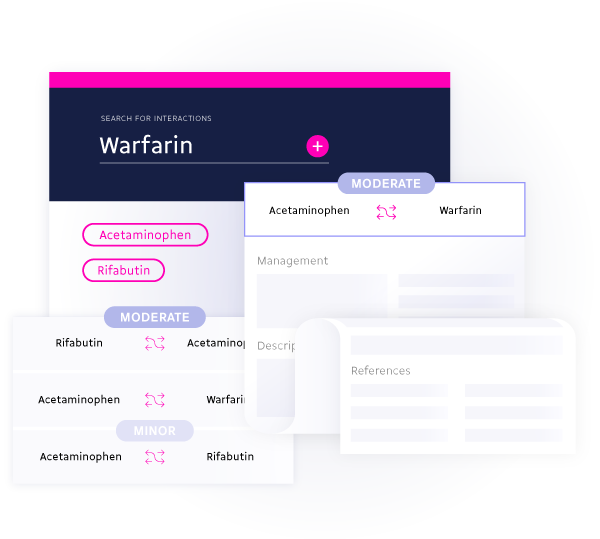
The drug interactions module is one of our most powerful features. In addition to being used for general education, this feature focuses on patient safety. It enables clinicians to quickly and easily check for drug interactions when adding a new medicine to a patient, or for potential, existing interactions causing problems. The drug interactions module includes references, severity levels, descriptions of the interactions and more, which all work together to help avoid potential warning fatigue while providing validated, accurate, and concise information.
Why users love it:
- Fast responses
- Checks interactions at the active ingredient level
- Simple and straightforward to understand
- Can take into account the routes of which a drug is administered
- Customizable to your needs
Click here for a more in-depth implementation guide

Drug Indications
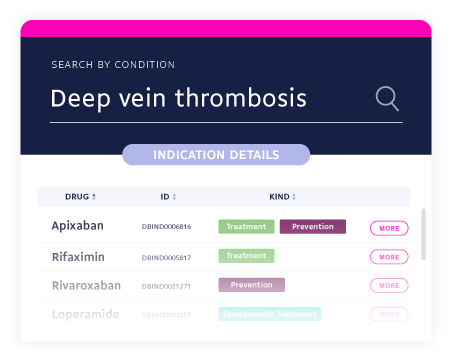
Based on label (monograph) and known, scientifically backed and professional approved off-label information, drug indications is a versatile module that enables you to bring prescribing, prospecting, and medication reviewing to the next level. Grounded in DrugBank’s deep pool of knowledge, drug indications provide your users excellent clinical decision support. Not only will this separate you from your competitors, it will lead to better health outcomes for patients.
Why users love it:
- Useful for many use cases
- Enables text search to look up drugs that treat a particular disease
- Easily search what a drug is indicated to treat
- Allows search for alternative drug treatments
- Allows search for duplicate therapies
- Includes off-label and over-the-counter indications
- ICD-10, SNOMED, and MedDRA mappings available
Click here for a more in-depth implementation guide
Adverse Effects
This powerful module provides deep insight into possible adverse effects that a drug might cause and has proven to be invaluable for hospice, EHR, and clinical users. When searching, it grabs information from beyond the labels, gathering adverse effect data from clinical trials all the way to patient adverse effects that have been reported to the FDA. This depth enables users to take a comprehensive look at a patient’s conditions and how they might be caused by a specific drug.
There are a couple ways to use the adverse effect module. You can search directly for possible drugs that are causing an adverse effect in general, or search for the possible adverse effects of a medication or medication list that a user might be taking. The search output will deliver a range of values that enable you to filter the adverse effects you want reflected to the user. This proves to be an extremely versatile tool that empowers you to find the best solutions to help you achieve your specific goals.
Why users love it:
- Depth of adverse effects information
- References of the adverse effects in the API
- Goes beyond the label of the drug products
- Allows for filtering and customization for your needs
- ICD-10, SNOMED and MedDRA mappings available
Click here for a more in-depth implementation guide
Drug Allergies
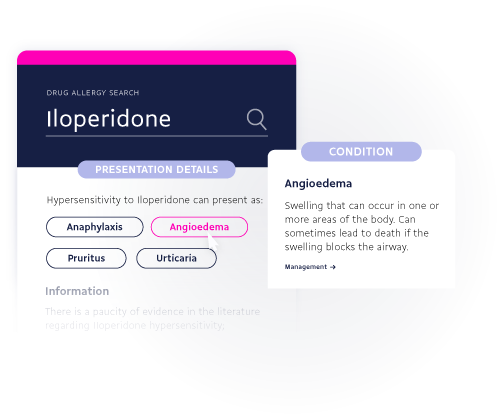
The drug allergies module is an immensely useful tool that helps evaluate when a user or patient is having an allergic reaction to one of the medications on their profile. For our clinical users, it enables physicians, nurses, and other healthcare professionals to evaluate possible allergic reactions quickly and accurately.
The allergies module also incorporates our validated allergy risk checker, which enables users to check for potential unknown drug allergies based on an existing known drug allergy. The addition of allergy risk tracker allows users to bring deeper insight to prescribing, making safer and more effective decisions possible.
In addition to this, the module is divided into sections that allows you to pick and choose the information you find relevant. This means that you will be able to focus on the important details instead of creating a large, difficult to navigate report that is full of unnecessary information.
Why users love it:
- Includes information about drugs a user might be allergic to based on other known allergies
- Simple and straightforward to understand
- In-depth information about drug allergies
- Includes allergy types and known offset times
- Includes how a drug allergy has been documented to present on the body
Click here for a more in-depth implementation guide
No matter your use case, our Clinical API provides a range of powerful tools to help you bring more certainty and speed to you and your user’s day. Depending on what your specific needs are it’s a good idea to explore a range of options to find the right module for you. Our customer success team has the know-how and experience to help you identify what will work best for you and guide you along the way as you get up and running.



